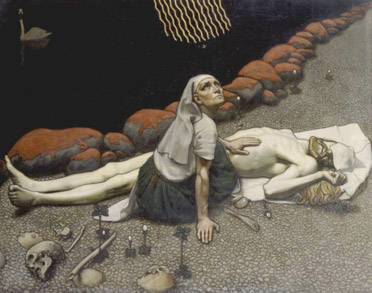
On a more mythic level, the group’s 2001 disc, Ilmatar, named for the Goddess of the Air who gave birth to the world, contained an epic curse, “Äijo’s Spell” with guest vocalist Ismo Alanko providing a bass echo that gives extra weight to the words. The insults hurled include “treacherous and cold-skinned viper, slithering and slit-eyed fiend.” The lyrics bid the creature to “hear and know your lowly provenance,” because to know a history and to name a creature is to have power over it in Finnish mythology, just as Väinämöinen had to know the origin of something like iron in order to use its power. The spell to cure the bite of the serpent adds to this knowledge of history a number of commands to the “hissing ghoul with jagged backside,” asserting “never shall my blood refresh you” and demanding “cleanse the grievous wound you gave me, rid my veins of this your venom” and declaring that he will be “forever banished.” While curses on the mythic level wield immense power, there is also a clarity of purpose in the more personal curse.
Laura Stark-Arola has written a great deal on the folk magic of women, including carefully mapping out the ways that women manipulated väki, the particular female energy that determined a woman’s success and standing in the community. Often rituals and charms were dependent upon the force of a woman’s väki and a curse like Värttinä’s “Riena” [Anathema] from Miero would rely on a powerful väki to make it a success. The rage is plain in lines like “I throw off sparks, I tear from my tongue words as twisted as tree-roots.” The words seek to make the magic palpable, even physical: “My loathing drips blood, my pain slashes, curses, drenches with pus.” While this particular song does not call on the gods, it does appeal to the previously cursed snakes, for how low must this betrayer be that “snakes also curse you, serpents of death, oh that hissing will enter your head…” While not one of the traditional Karelian curses, one can’t help feeling it would prove just as efficacious.
In this brief piece, I can give you little more than an introduction to these lively and living magical traditions. There’s not even time to get to the excellent compilation CD Wizard Women of the North which contains a number of haunting tunes from the eerie herding calls to songs of incantation. To say nothing of the other groups whose names I invoked at the start, Garmarna who sing to the spring goddess Suvetar, “Feed us with honey-hearts, give us honey-drink” or Hedningarna who call out, “Strike a fire, father of winds, send out lightning, Väinämöinen.” I only hope that we can provoke such a rich response in pagan-themed music on this side of the Atlantic one day.
 Page 4 | 4
Page 4 | 4
Works cited:
Bosley, Keith, trans. The Kanteletar. Oxford UP, 1992.
Friberg, Eino, trans. The Kalevala: Epic of the Finnish People. Otava: 1989.
Stark-Arola, Laura. Magic Body And Social Order. Finnish Literature Society: 2000.
Värttinä website: http://www.varttina.com/
K.A. Laity is the author of Pelzmantel (Immanion Press 2010) and Unikirja (Aino Press 2009) as well as many short stories, essays and plays. A tenured professor of English, she also writes a weekly column for Bitchbuzz.com , the global women’s lifestyle network.
Visit her website at www.kalaity.com for news, book trailers and more, or join her on Facebook and Twitter.








